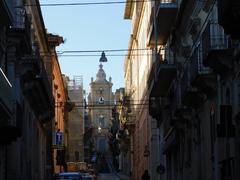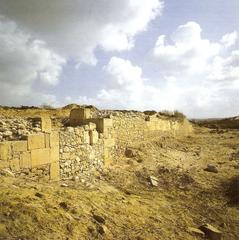Church of Saint Agnes Ragusa: Visiting Hours, Tickets, and History Guide
Date: 14/06/2025
Introduction
Set in the atmospheric lanes of Ragusa Ibla, the Church of Saint Agnes (Chiesa di Sant’Agnese) is a remarkable testament to the city’s enduring faith, distinctive Baroque architecture, and layered historical narrative. Erected atop the ruins of the older Church of San Giovanni Battista, this church has weathered centuries of change, including the seismic upheaval of the 1693 earthquake that transformed southeastern Sicily (Heritage Sicily; Italy We Love You). Today, it remains both a place of worship and a cultural landmark, inviting visitors to experience its artistic, spiritual, and historical riches.
This guide will provide a detailed overview of the church’s origins, architectural features, practical visitor information, and its essential role in Ragusa’s cultural landscape. Whether you are a history buff, a lover of Baroque art, or a traveler seeking to connect with Sicily’s traditions, the Church of Saint Agnes offers a meaningful and memorable experience.
Table of Contents
- Historical Origins and Architectural Evolution
- Significance After the 1693 Earthquake
- Architectural and Artistic Highlights
- Visitor Information: Hours, Admission, and Etiquette
- Tips for Visiting and Accessibility
- Nearby Attractions in Ragusa Ibla
- Cultural Context: Faith and Community
- Frequently Asked Questions (FAQs)
- Summary and Visitor Tips
- References and Further Reading
Historical Origins and Architectural Evolution
The Church of Saint Agnes is a product of Ragusa’s resilience and adaptability. Its origins can be traced to the early 18th century, when the city was rebuilding after the devastating 1693 earthquake. The new church was constructed atop the remains of the Church of San Giovanni Battista, whose destruction was compounded by acts of vandalism. Rather than erasing the past, the builders integrated remnants of the older structure—such as distinctive arches from the original altars—into the new church (Heritage Sicily). This architectural palimpsest is emblematic of Sicilian heritage, where sacred spaces often maintain their sanctity across centuries and transformations (Italy We Love You).
Significance After the 1693 Earthquake
The 1693 earthquake reshaped the entire Val di Noto, including Ragusa, which was divided into Ragusa Superiore and Ragusa Ibla. The reconstruction period saw a flourishing of Sicilian Baroque architecture, with the Church of Saint Agnes rebuilt in a style that harmonized with the city’s new vision (italygonia.com; twogetlost.com). Though smaller than the grand Duomo di San Giorgio, Saint Agnes’ church is an important part of the urban and spiritual fabric of Ragusa Ibla, serving as a point of continuity amidst urban transformation (cheerfultrails.com; passportnomads.com).
Architectural and Artistic Highlights
Exterior
The church’s façade is a refined example of Sicilian Baroque, featuring decorative pilasters, volutes, and modest sculptural embellishments. Warm local limestone and harmonious proportions create a welcoming and intimate impression. The bell tower, with its decorative dome, rises gracefully and complements the picturesque skyline of Ragusa Ibla.
Interior
Inside, the nave is flanked by Corinthian columns and illuminated by natural light filtering through the large windows. Elegant stucco work, barrel-vaulted ceilings, and frescoes depict scenes from the life of Saint Agnes and other religious motifs. The high altar, adorned with polychrome marble and gilded wood, displays a revered statue or painting of the patron saint. Side chapels house additional artworks crafted by local artists, and the remnants of the old San Giovanni Battista arches are still visible, emphasizing the church’s deep historical roots (twogetlost.com).
Artistic Details
The interior decoration reflects the influence of the Serpotta school, with intricate stucco angels, allegorical figures, and the use of polychrome marble reminiscent of Palermo’s ecclesiastical masterpieces. The art and craftsmanship reinforce the church’s role as both a spiritual and artistic beacon within the community.
Visitor Information: Hours, Admission, and Etiquette
- Opening Hours: The Church of Saint Agnes is generally open daily from 9:00 AM to 12:30 PM and 4:00 PM to 7:00 PM, though hours may adjust for religious festivals or special events. Always confirm locally or with the Ragusa tourism office.
- Admission: Entry is free; donations are welcomed to support ongoing preservation efforts.
- Tickets: No ticket is required.
- Dress Code: Modest attire is required—shoulders and knees should be covered. Scarves or shawls are handy for warmer months (wearwhenwhatwhy.com; jamtraveltips.com).
- Photography: Generally permitted without flash, except during services or where signage indicates otherwise.
- Etiquette: Maintain silence and respectful behavior, especially if services or prayers are underway. Remove hats and switch mobile devices to silent mode.
Tips for Visiting and Accessibility
- Best Times: Spring (April–June) and autumn (September–October) offer pleasant weather and fewer tourists (theroadreel.com; eternalarrival.com).
- Guided Tours: Many walking tours of Ragusa Ibla include the church. Self-guided options via audio apps like Audiala are also available.
- Getting There: The church is located in pedestrian-friendly Ragusa Ibla; parking is available on the town’s edge. Explore on foot for the best experience.
- Accessibility: Due to the historic setting, surfaces are uneven and the church has steps at the entrance, making wheelchair access limited. Contact local offices for assistance if needed.
- Language: Italian is primary, but basic English is spoken in tourist areas. Simple Italian greetings are appreciated.
- Safety: Ragusa is generally safe; take standard traveler precautions.
Nearby Attractions in Ragusa Ibla
After visiting the Church of Saint Agnes, consider:
- Duomo di San Giorgio: Iconic Baroque cathedral.
- Giardino Ibleo: Historic public garden with panoramic views.
- Chiesa di San Giuseppe: Another beautiful Baroque church.
- Local cafés and artisan shops: Enjoy Sicilian pastries, ceramics, and Modica chocolate (thegoguy.com; storiesbysoumya.com).
Cultural Context: Faith and Community
Ragusa’s more than 50 churches not only showcase architectural splendor but also serve as focal points for social and spiritual life (Italy We Love You; Berkley Center). The Church of Saint Agnes, dedicated to one of Christianity’s most venerated martyrs, hosts regular Mass and annual celebrations, especially on Saint Agnes’ feast day (January 21). These events provide visitors with a chance to observe and participate in authentic Sicilian traditions (catholicnewsagency.com).
Supporting the church through donations, purchasing candles, or contributing to local artisans helps preserve Ragusa’s cultural and artistic heritage.
Frequently Asked Questions (FAQs)
Q: What are the visiting hours?
A: Usually 9:00 AM to 12:30 PM and 4:00 PM to 7:00 PM, though hours may vary for festivals or special events.
Q: Is there an entrance fee or ticket required?
A: No, entry is free; donations are appreciated.
Q: Are guided tours available?
A: Yes, through local operators or as part of broader walking tours in Ragusa Ibla.
Q: What is the dress code?
A: Shoulders and knees must be covered. Scarves are useful for extra coverage.
Q: Can I take photos inside?
A: Photography is generally allowed without flash except during services.
Q: Is the church accessible for people with mobility challenges?
A: Accessibility is limited due to historic architecture; contact the parish or tourism office for specific assistance.
Summary and Visitor Tips
The Church of Saint Agnes in Ragusa Ibla is a living symbol of Sicily’s enduring faith, artistic legacy, and community spirit. Its history—spanning medieval origins, Baroque reconstruction, and modern-day worship—reflects Ragusa’s resilient identity (Heritage Sicily; italygonia.com). Visitors are encouraged to approach their visit with respect for local customs and to take advantage of guided tours and audio resources for a deeper understanding.
For an enriched experience, time your visit around Saint Agnes’ feast day or integrate your trip with other Baroque treasures in Ragusa. Though accessibility is limited, the church’s intimate atmosphere and historical resonance make it a must-see for anyone exploring southeastern Sicily.
References and Further Reading
- Visiting the Church of Saint Agnes in Ragusa: History, Hours, and Nearby Attractions
- Ragusa Italy: All You Must Know Before You Go
- Exploring Ragusa Ibla: A Short Guide, Passport Nomads
- Chiesa di S. Agnese, Ragusa, Heritage Sicily
- Ragusa Italy, Italy We Love You
- Italy: A Country of Churches, Secularization’s Impact on a Historically Catholic Society, Berkley Center
- Things to Do in Ragusa Sicily, Eternal Arrival
- Best Things to Do in Ragusa, The Go Guy
- Guide to Visiting Ragusa Sicily, The Road Reel
- The Origins of St. Agnes: Child Saint and Martyr, Catholic News Agency
- Things to Do Ragusa Sicily, Stories by Soumya
For current visiting hours, event schedules, and more, download the Audiala app or visit our related articles on Ragusa’s historical sites. Follow us for updates, travel tips, and exclusive content on Sicily’s Baroque wonders.

